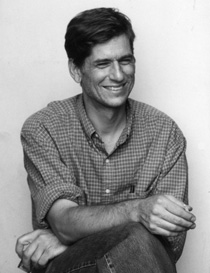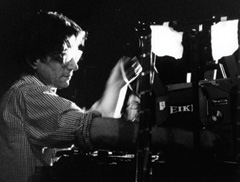 |
|
||||||
|
|
||||||||||||||||||||||||||||||||||||||||||||||||||||||||||||||||||||||||||||||||||||||||
|
Smoke and mirrors: Performance art bends the senses by DENISE YOUNG
McClure calls his work "projection performance." His tools include not brushes and canvas but those of cinema--projectors, shuttered lamplights, exciter bulbs, the optical sound system, and minimal amounts of film. In the art world, McClure's work has won major recognition. He's been in two Whitney Biennial exhibitions and received the Herb Alpert Award, the latter of which includes a $75,000 prize. McClure avoids the words "art" and "artist" for the archetypical images they conjure up: museums and the artist who walks away from the work he or she creates. "I don't spend a lot of time paying attention to what other people are doing because I realize what I'm doing is its own sort of creature," he said. "I always believed in trying to stay outside of certain definitions. But I thought I should have a job, go into an office and work nine to five, and then come home and turn to other pursuits." McClure's compositions are slow and intense. "It's pretty grueling as far as the audience is concerned." Unlike television shows or films, in which a great deal happens in 30 minutes or a couple hours, McClure's 45-minute to one-hour compositions are akin to walking along a picket fence, running a stick across the pickets while peering through the slots. "The kind of action you see on the screen is very limited. It might be a scene of a bird turning its head, but as the scene repeats itself over and over, there's subtle variation with sound and light." Ray Kass, a retired faculty member in the art department at Virginia Tech, remains close to his former student, attending McClure's exhibitions and bringing him back to campus in 2000 and 2005 to share his work. "Bruce's work deconstructs film itself into its component parts, like working on film as a projected surface as opposed to dealing with a photographic image--skipping the camera," said Kass, who noted that Marcel Duchamp's Rotoreliefs were a major influence on McClure. McClure's recent performance pieces Ventriloquent Agitators and Pie Pelicane Jesu Dominae will be shown as part of two October performances at the Harvard Film Archive, housed in the Carpenter Center for the Visual Arts. His inspirations are many and varied: the geometry of weights used in surf fishing, the registry of colors in melting lead, vaudeville, and the rhythm of the metronome. "There are these relationships between what you see and what you hear. It's sort of Pythagorean," he said of the metronome, the movement of which can be interpreted in his work. "You observe the weight on the inverted pendulum and experience tempo as a swing, to and fro, with an attendant ticking sound." This attention to movement is the center of each piece. There is no focus on plot or character development. Instead, the film is stripped bare and pared down so the focal point is the subtlety, the intentionality of each color, every shadow, sound, flash, or bit of image projected, moving from what McClure calls the mechanic medium to the human medium. "I like movie projectors. I like their shutters and light intervals, the way they work--strobe lights, lighthouses, sirens, and other flashing lights," he said, listing his fascinations. McClure's work has more in common with a music concert than a showing at an art gallery. It's abstract art brought to life--only instead of a few brushstokes on a canvas, the audience has light on a black backdrop with accompaniment of sound. Live performance is vital to each of McClure's works--a distinction, he noted, from more traditional art forms. A painter might never be seen side by side with a painting. A film shown at a festival is distant from the director behind the lens. McClure prefers to be "on the frontline," enacting each composition in the presence of the audience. Yet one difference separates his work from that of the stage performer. "Picture Judy Garland being pushed out on the stage with the lights pointing at her. She's preparing to perform for a packed house, but all she can see is the light shining on her. Instead of being pushed out on an empty stage, I'm down with the people on the floor. I'm throwing light onto the stage, and the speakers are facing me. It's some sort of mirror image between what we associate with performance and what I call projection performance. I'm throwing a voice out into the room, but from the other side of the proscenium arch," he said. In his years at Tech, McClure remembers a professor saying that the College of Architecture and Urban Studies "was a place where one was permitted to fail." For McClure, this meant the college became a bastion of free thought where he was able to minimize vocational training in order to soak up the university's offerings in art, literature, philosophy, and film. "It was a good place just for the richness of ideas and so forth," he said. He also appreciated the affordability of Virginia Tech, which left room for exploration. He spent two years abroad in Italy, long enough to study Italian, learn the bus routes, and intern with Ivano Gianola, an architect whose work he admired. Kass's encouragement influenced McClure at Tech. "Ray's self-appointed mission was to bring some of the culture from New York down to Blacksburg," McClure said. Kass founded the Mountain Lake workshops, at which McClure met many figures of the art-world intelligentsia, including composer John Cage, who would be an influence on him not only at the workshops in 1983, 1988, and 1990, but also when McClure moved to New York after graduation. In New York, Kass introduced McClure to Ed Knowles, a "kindred spirit" who provided McClure with an invaluable three-year architectural stint. McClure worked as a draftsman until 2008, when two events collided that would shape the next few years of his career. His work at an architectural firm dried up during the economic downturn, and he received the Alpert award. Nominated by an unknown source, McClure was distrustful of packaging something performative into an award application. Though he applied in deference to the nominator, he now has mixed feelings about the role of living off art, finding it fairly labor-intensive for the compensation. "It's one of the most generous awards in the arts, and it's burning a big artistic hole in my professional résumé. As far as being a draftsman is concerned, I haven't worked in two years. I've been traveling around the world, and I have nothing to show for it--not even a trophy. I'm in the 'in-between,' and I don't think the life of an professional artist is for me." Nevertheless, the experience has provided McClure a sturdy platform for his next jump into the space between the mechanic medium and human medium, wherever the jump takes him. "I became the monster I didn't want to become," he joked, "but it's been good because I got to show a lot of places I wouldn't have otherwise." The show goes on, this performance artist creating patterns and sounds in the darkness. Perhaps somewhere inside McClure there is still a young man snuffing the light out, allowing the pure shadow to seep under the skin, and turning the lamp on again. |
|
|||||||||||||||||||||||||||||||||||||||||||||||||||||||||||||||||||||||||||||||||||||||
|
|




